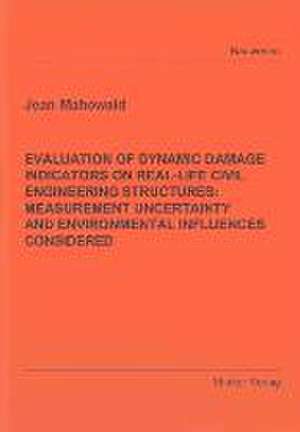EVALUATION OF DYNAMIC DAMAGE INDICATORS ON REAL-LIFE CIVIL ENGINEERING STRUCTURES: MEASUREMENT UNCERTAINTY AND ENVIRONMENTAL INFLUENCES CONSIDERED: Berichte aus dem Bauwesen
Autor Jean Mahowalden Limba Engleză Paperback – 25 mar 2014
Din seria Berichte aus dem Bauwesen
-
 Preț: 97.74 lei
Preț: 97.74 lei -
 Preț: 261.28 lei
Preț: 261.28 lei -
 Preț: 279.53 lei
Preț: 279.53 lei -
 Preț: 64.62 lei
Preț: 64.62 lei -
 Preț: 271.46 lei
Preț: 271.46 lei -
 Preț: 263.92 lei
Preț: 263.92 lei -
 Preț: 372.06 lei
Preț: 372.06 lei -
 Preț: 297.05 lei
Preț: 297.05 lei -
 Preț: 302.16 lei
Preț: 302.16 lei -
 Preț: 278.38 lei
Preț: 278.38 lei -
 Preț: 260.14 lei
Preț: 260.14 lei -
 Preț: 264.14 lei
Preț: 264.14 lei -
 Preț: 263.70 lei
Preț: 263.70 lei -
 Preț: 244.64 lei
Preț: 244.64 lei -
 Preț: 260.58 lei
Preț: 260.58 lei -
 Preț: 263.13 lei
Preț: 263.13 lei -
 Preț: 243.69 lei
Preț: 243.69 lei -
 Preț: 280.91 lei
Preț: 280.91 lei -
 Preț: 261.17 lei
Preț: 261.17 lei -
 Preț: 264.95 lei
Preț: 264.95 lei -
 Preț: 272.40 lei
Preț: 272.40 lei -
 Preț: 403.40 lei
Preț: 403.40 lei -
 Preț: 245.00 lei
Preț: 245.00 lei -
 Preț: 273.79 lei
Preț: 273.79 lei -
 Preț: 263.56 lei
Preț: 263.56 lei -
 Preț: 286.80 lei
Preț: 286.80 lei -
 Preț: 417.90 lei
Preț: 417.90 lei -
 Preț: 269.44 lei
Preț: 269.44 lei -
 Preț: 264.51 lei
Preț: 264.51 lei
Preț: 291.84 lei
Nou
Puncte Express: 438
Preț estimativ în valută:
55.85€ • 59.72$ • 46.56£
55.85€ • 59.72$ • 46.56£
Carte indisponibilă temporar
Doresc să fiu notificat când acest titlu va fi disponibil:
Se trimite...
Preluare comenzi: 021 569.72.76
Specificații
ISBN-13: 9783844026733
ISBN-10: 3844026738
Pagini: 246
Ilustrații: 129 farbige Abbildungen
Dimensiuni: 149 x 210 x 19 mm
Greutate: 0.34 kg
Editura: Shaker Verlag
Seria Berichte aus dem Bauwesen
ISBN-10: 3844026738
Pagini: 246
Ilustrații: 129 farbige Abbildungen
Dimensiuni: 149 x 210 x 19 mm
Greutate: 0.34 kg
Editura: Shaker Verlag
Seria Berichte aus dem Bauwesen
